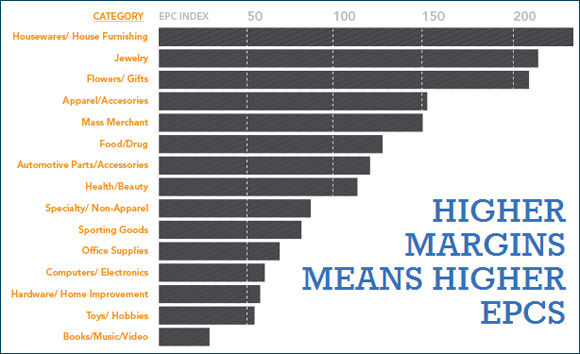Earlier this week VigLink announced the launch of its quarterly “content commerce reports.” They will be based on the data from the VigLink network of publishers/affiliates, and will be published with the goal of shedding light on key monetization metrics of the content marketing landscape. Here’s just one interesting piece of data from their very first report (which covers Q4 2013 performance):

[Source: Q4 2013 Content-Commerce Report by VigLink]
To dig a little deeper into the things that undergird this report I’ve reached out to Oliver Deighton, VigLink’s VP of Marketing, to ask him a few questions.
Below I bring you my interview with him:
Geno: First of all, congratulations on launching your quarterly “Content-Commerce Reports.” To make sure we read your first report right, could you please clarify if “EPC” in it stands for a true “per click” affiliate earnings, or “EPC” as the KPI is used by most U.S. affiliate networks?
Oliver: Thanks Geno. What we’re reporting in most of these charts is an Indexed EPC. Let’s unpack that. When we say “EPC,” we are referring to a true “per click” metric. We simply divide the total number of clicks into the total earnings to provide an average earnings per click (not per one hundred clicks). When we say “Indexed,” we mean that we’ve normalized the EPCs. Here, that means the average EPC is 100 and everything else is either above or below the average. For example, in the report we see that forum sites enjoy an Indexed EPC of 151. That means they earn 51% more per click than the average across all sites. Blogs, on the other hand, have and Indexed EPC of 72, so they earn 28% less per click compared to the average. We do all this crazy complicated math stuff because we don’t want to mislead anyone. The actual dollars and cents vary for each publisher.
Geno: Do the “300k+ active sites” that were analyzed represent all content publishers that use VigLink?
Oliver: Every publisher site that uses VigLink is eligible to influence this report. In other words, we didn’t take a subset of our network and start there. We started with every click from every site to every merchant. Then, as we analyzed the data, individual sites and merchants would naturally fall out of specific reports if they didn’t send or receive a click. For example, if a publisher didn’t send a click to one of the merchants in the top 50, then they aren’t part of that chart. This is our best effort at a representation of the content-driven commerce flowing through our network.
Geno: What are some of the top content publishers that monetize their properties via VigLink’s solutions?
Oliver: We’re proud to be working with many of the top publishers on the web today. Sites like The Huffington Post, PC World, Mac World, Daily Candy, Design Sponge, Complex, and many more represent niche communities, expert content, and enthusiast discussions that help readers discover new products and research their next purchase.
Geno: What is “exchange pricing” and/or “VigLink Exchange” to which you refer in the report?
Oliver: Within our network, every day more and more clicks from publishers to merchants are priced, bought, and sold through the VigLink Exchange. In our exchange, clicks are put up for auction and won by the highest bidding merchant. For instance, some publishers have opted into our link optimization technology. This technology takes advantage of the fact that multiple retailers sell the same product. When we find an existing link pointing to one of these products we can change that link to point to the highest bidding retailer. We determine the highest bidding retailer via the VigLink Exchange. In Q4, our Exchange technology lifted EPCs by 2x-3x.
Geno: You’ve concluded that “mobile EPCs” were roughly “half that of desktop” (or for every $1.00 paid out for desktop referrals, about $0.53 were paid for mobile). Do you have any insight into how CRs (conversion rates) and AOVs compared between the two?
Oliver: This is a great question and one we want to explore further. In our initial look into this, we found that when a merchant pays more for their desktop clicks, it was generally because their desktop clicks converted better than their mobile clicks (mobile taps?). When a merchant pays more for mobile clicks (yes, that actually does happen!) it’s usually because mobile clicks converted better than desktop clicks. Average order values tended to play a less significant role in determining EPC. We hope to provide more insight into m-commerce in future reports.
Looking forward to future VigLink reports then. In the meantime, enjoy this one.
Pingback: Marketing Day: March 17, 2014